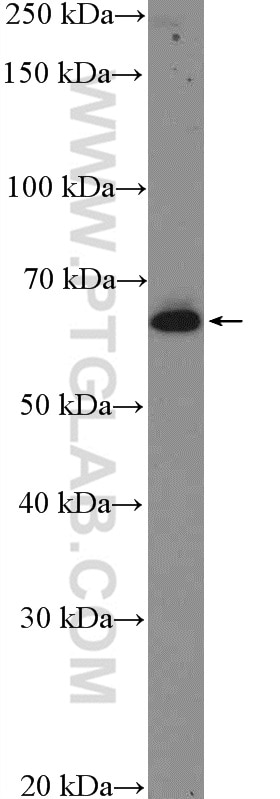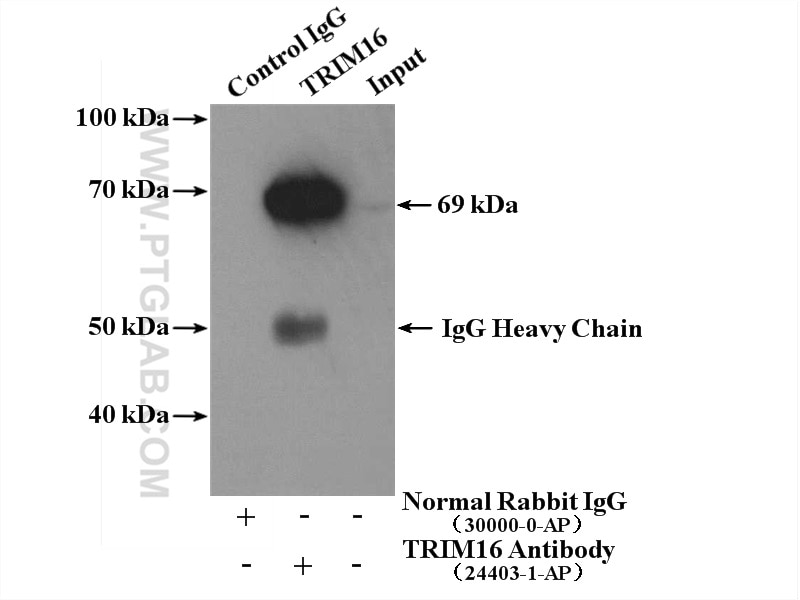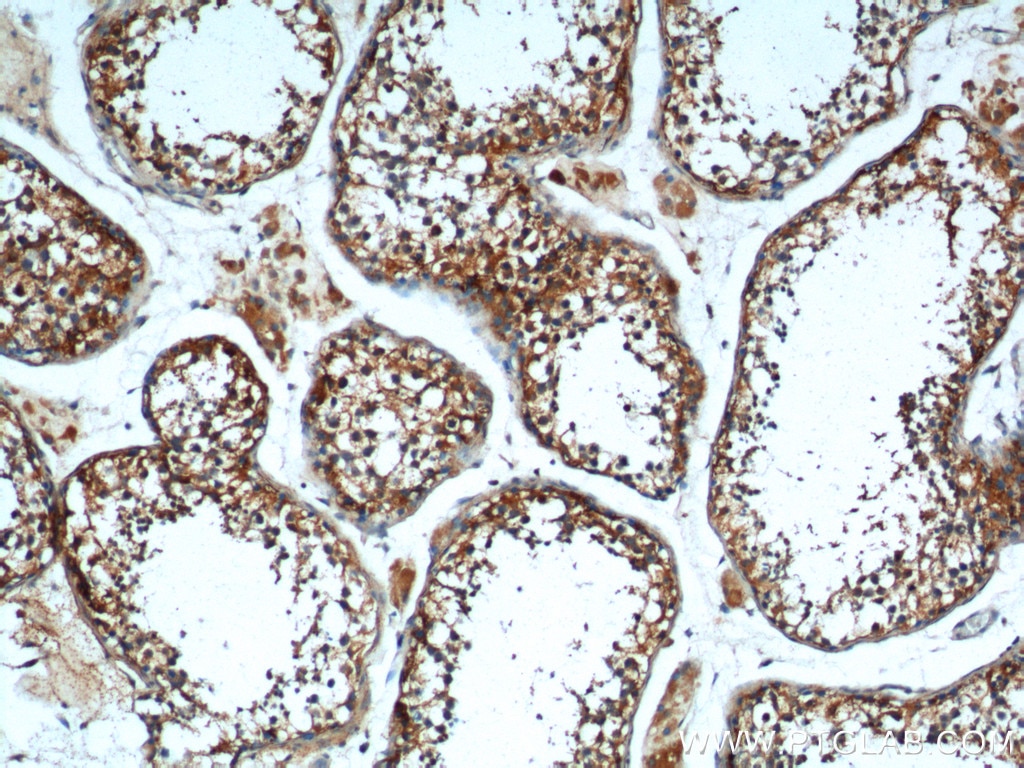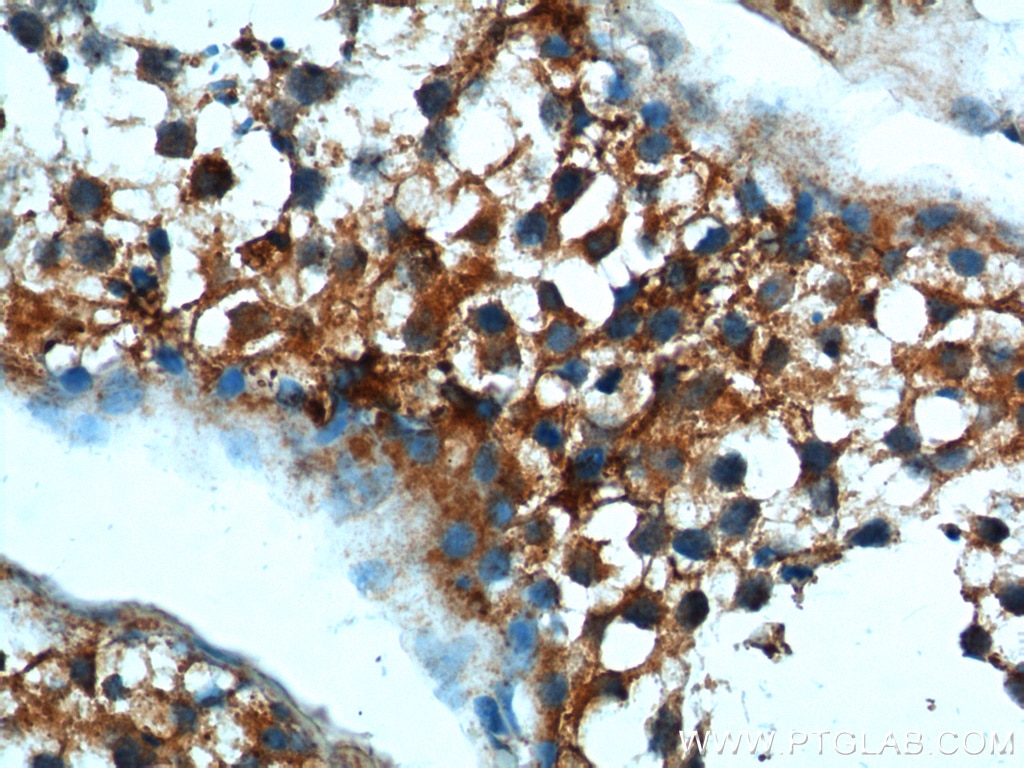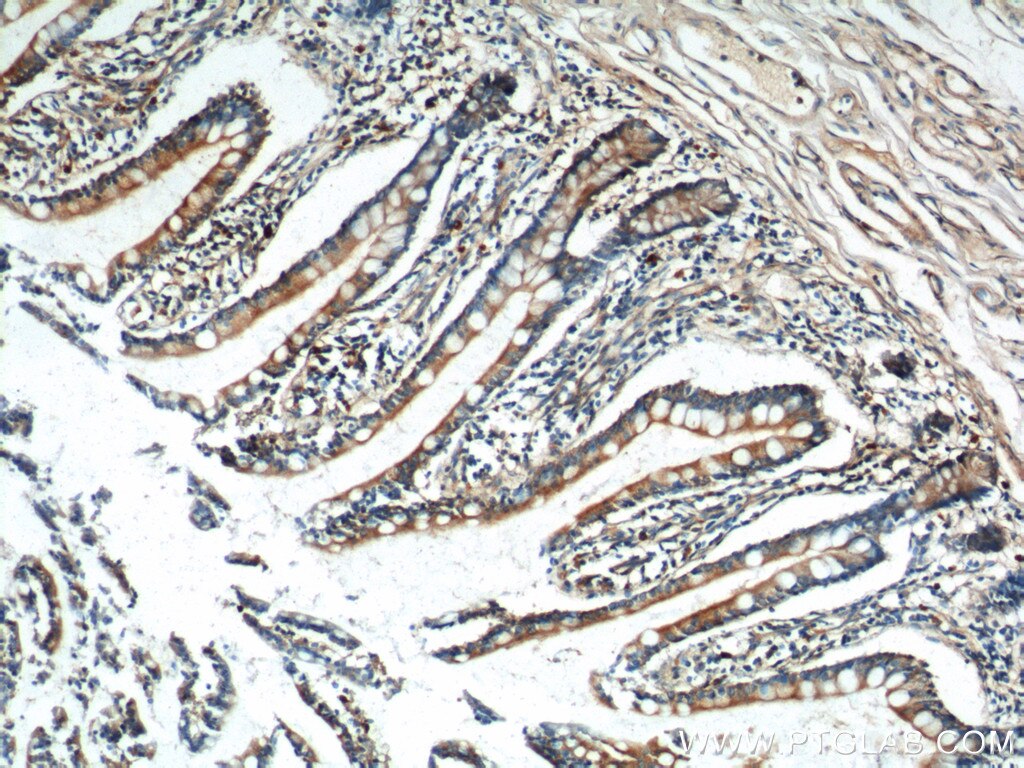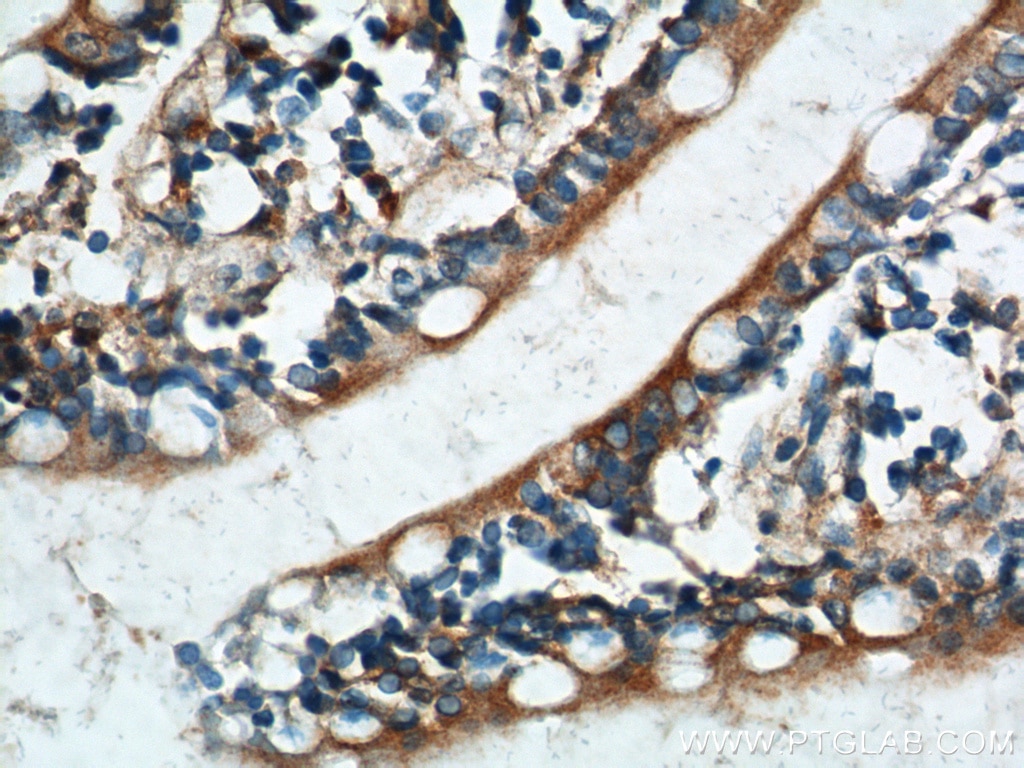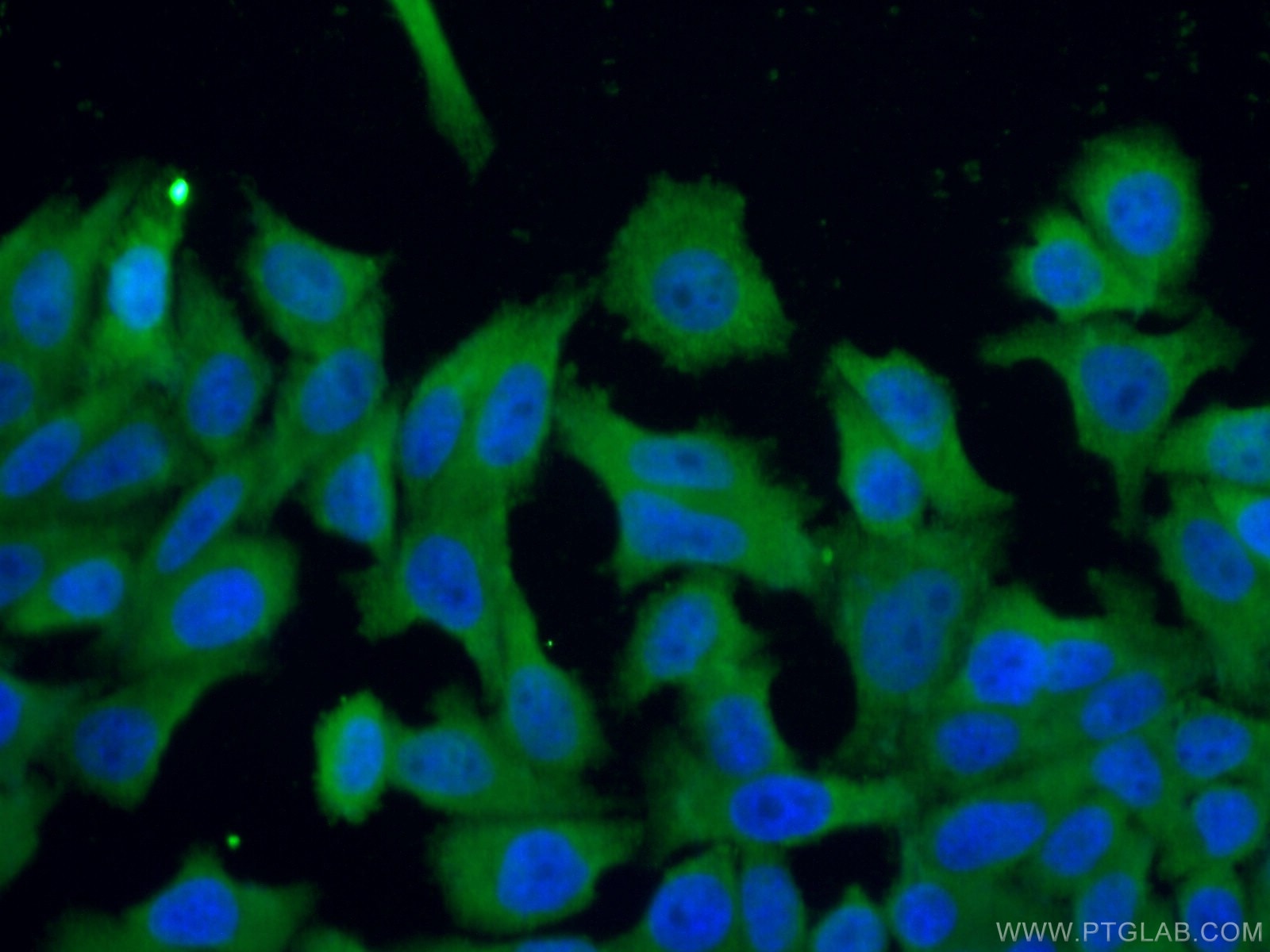- Phare
- Validé par KD/KO
Anticorps Polyclonal de lapin anti-TRIM16
TRIM16 Polyclonal Antibody for WB, IHC, IF/ICC, IP, ELISA
Hôte / Isotype
Lapin / IgG
Réactivité testée
Humain et plus (1)
Applications
WB, IHC, IF/ICC, IP, CoIP, ELISA
Conjugaison
Non conjugué
N° de cat : 24403-1-AP
Synonymes
Galerie de données de validation
Applications testées
| Résultats positifs en WB | cellules HepG2 |
| Résultats positifs en IP | cellules HeLa |
| Résultats positifs en IHC | tissu testiculaire humain, tissu d'intestin grêle humain il est suggéré de démasquer l'antigène avec un tampon de TE buffer pH 9.0; (*) À défaut, 'le démasquage de l'antigène peut être 'effectué avec un tampon citrate pH 6,0. |
| Résultats positifs en IF/ICC | cellules HepG2 |
Dilution recommandée
| Application | Dilution |
|---|---|
| Western Blot (WB) | WB : 1:500-1:1000 |
| Immunoprécipitation (IP) | IP : 0.5-4.0 ug for 1.0-3.0 mg of total protein lysate |
| Immunohistochimie (IHC) | IHC : 1:50-1:500 |
| Immunofluorescence (IF)/ICC | IF/ICC : 1:20-1:200 |
| It is recommended that this reagent should be titrated in each testing system to obtain optimal results. | |
| Sample-dependent, check data in validation data gallery | |
Applications publiées
| KD/KO | See 5 publications below |
| WB | See 10 publications below |
| IHC | See 4 publications below |
| IF | See 1 publications below |
| CoIP | See 1 publications below |
Informations sur le produit
24403-1-AP cible TRIM16 dans les applications de WB, IHC, IF/ICC, IP, CoIP, ELISA et montre une réactivité avec des échantillons Humain
| Réactivité | Humain |
| Réactivité citée | Humain, souris |
| Hôte / Isotype | Lapin / IgG |
| Clonalité | Polyclonal |
| Type | Anticorps |
| Immunogène | TRIM16 Protéine recombinante Ag21406 |
| Nom complet | tripartite motif-containing 16 |
| Masse moléculaire calculée | 64 kDa |
| Poids moléculaire observé | 64 kDa |
| Numéro d’acquisition GenBank | BC015674 |
| Symbole du gène | TRIM16 |
| Identification du gène (NCBI) | 10626 |
| Conjugaison | Non conjugué |
| Forme | Liquide |
| Méthode de purification | Purification par affinité contre l'antigène |
| Tampon de stockage | PBS with 0.02% sodium azide and 50% glycerol |
| Conditions de stockage | Stocker à -20°C. Stable pendant un an après l'expédition. L'aliquotage n'est pas nécessaire pour le stockage à -20oC Les 20ul contiennent 0,1% de BSA. |
Informations générales
TRIM16 (tripartite motif-containing protein 16) is an E3 ubiquitin ligase belonging to the tripartite motif (TRIM) protein family, mediates the ubiquitination of its target proteins and tags them for degradation. TRIM16 controls ubiquitination of damaged compartments and regulates the core autophagy regulators ULK1, Beclin 1, and ATG16L1, which confer localized autophagic sequestration of damaged lysosomes (PMID: 27693506, 22629402). TRIM16 overexpression also enhances retinoidinduced differentiation, reduces neuroblastoma cell growth, migration, and significantly reduces tumorigenicity in vivo (PMID: 36504902).
Protocole
| Product Specific Protocols | |
|---|---|
| WB protocol for TRIM16 antibody 24403-1-AP | Download protocol |
| IHC protocol for TRIM16 antibody 24403-1-AP | Download protocol |
| IF protocol for TRIM16 antibody 24403-1-AP | Download protocol |
| IP protocol for TRIM16 antibody 24403-1-AP | Download protocol |
| Standard Protocols | |
|---|---|
| Click here to view our Standard Protocols |
Publications
| Species | Application | Title |
|---|---|---|
Front Cell Dev Biol TRIM16 Promotes Osteogenic Differentiation of Human Periodontal Ligament Stem Cells by Modulating CHIP-Mediated Degradation of RUNX2.
| ||
J Genet Genomics RASSF6-TRIM16 axis promotes cell proliferation, migration and invasion in esophageal squamous cell carcinoma. | ||
Exp Cell Res TRIM16 protects human periodontal ligament stem cells from oxidative stress-induced damage via activation of PICOT. | ||
Exp Cell Res TRIM16 overexpression inhibits the metastasis of colorectal cancer through mediating Snail degradation.
| ||
Cell Prolif G3BP1 coordinates lysophagy activity to protect against compression-induced cell ferroptosis during intervertebral disc degeneration | ||
Mol Carcinog TRIM16 E121D variant affects the risk and prognosis of hepatocellular carcinoma by modulating the Wnt/β-catenin pathway
|
